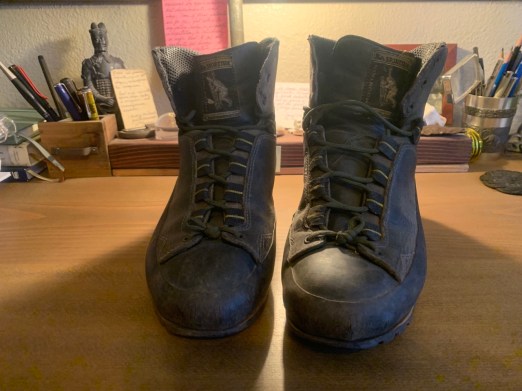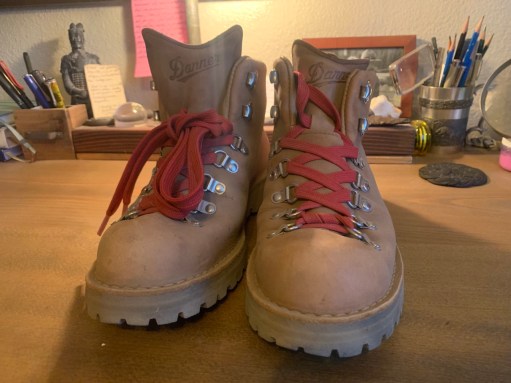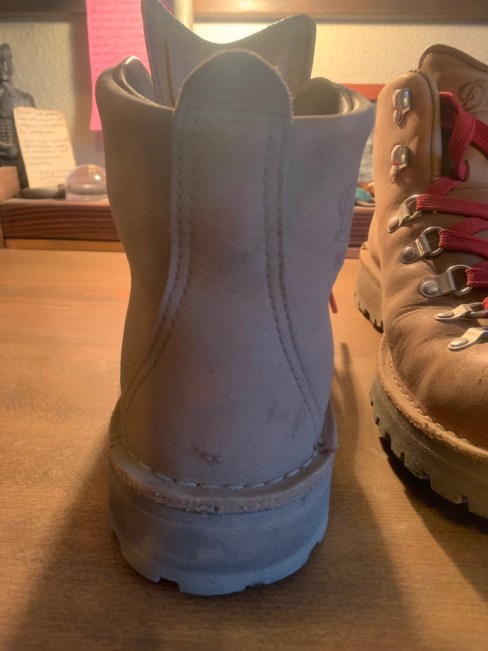For this last post in the series we get into all the “extras,” to include anything that doesn’t fit elsewhere. I’ll also describe things I had but wish I hadn’t and hadn’t but wish I had. That will make more sense later. Some of these things I never used but I wouldn’t leave home without. A lot of this falls into the ‘ten essentials‘ or my version of a ‘possibles kit.’
Hill People Gear Chest Kit
I really wanted to love this piece of kit. The main purpose of this kit is to have certain pieces of gear always at hand, even if you take off your pack. There’s just too many downsides relative to an extended backpacking trip.

While “everything” is readily at hand, it is heavy and retains heat. Notice in the picture Arlyn is wearing a lighter version? And the sweat stain underneath? If it is cold out you won’t mind the heat retention until you stop and the sweat starts evaporating.
Another downside is layering clothing. When you put on your rain gear or an insulating layer, you either have to take this off first or cover up the gear you wanted to have easy access to. It also doesn’t hide my ‘dunlap’ tire…
I’m going to repurpose this SAR. Paired with my day pack, I think it will be perfect for man-tracking missions.
Okay, So What’s In It?
- Small flashlight, LED, bright, single CR123 battery
- Leatherman Wave multitool, +/- 20 years old, original (no bit drivers), my favorite multitool that I carried everyday at work
- Orange/pink signal panel
- Signal mirror, small
- Whistle
- Gun shot wound trauma kit (because the kit is designed to carry a pistol…)
- Large bandana from SOLO ALEC course, has a ‘SOAP’ note on it
- Rite-in-the-Rain notepad with map tools
- Rite-in-the-Rain pen with lighted tip
- Small Pentel mechanical pencil
- Map of our planned trip & AO
- Suunto MC-2 G Mirror compass
- iPhone
- Jaybird bluetooth, water proof ear buds
- small lens cleaning cloth
- Big lighter in an Exotac ‘Fire Sleeve’
- On the outside is bear spray in a Mystery Ranch case and my big knife
Fixed Blade Knife
The big knife is a Chax Knives ‘Warrior Spirit’ in a custom Sagewood Gear leather sheath. The knife is heavy and sturdy enough for digging and batoning. That means I can leave behind the cat hole shovel and camp axe. The sheath is a ‘scout carry’ (horizontal) and has an integrated magnesium rod and a small tin of fire tinder. I love this knife and carry it everywhere.
In My Pockets
And truth be told these are always in my pockets:
- ‘Kutmaster’ two-bladed pen knife
- OLight i3T EOS, brass
- Fisher Space Pen, brass ‘bullet-style’
- Zippo lighter, brass
- Challenge coin, the four Stoic virtues from The Daily Stoic*
- one Lira coin (from Italy before the Euro), featuring daVinci’s ‘Vitruvian Man’*
*The significance of the coins are a much longer conversation we can have later.
The knife and lighter were my grandfather’s, both from his time in service. The Italian Lira is from my shore leave there in 1994. A note on the lighter — I have another Zippo, also brass, from my time in the Navy. I had engraved it for a Christmas gift and when he stopped smoking my dad gave it back to me. Anyway, I tried putting it in a Thyrm ‘Pyrovault’ so I could leave papaw’s at home.


It looks great and holds a wad of fire-starter in the bottom (fuel-impregnated cotton). Problem is it doesn’t fit correctly and thus makes striking impossible. Also the fluid evaporates within 24-48 hours. I left it at home. I’ll consider getting a butane insert from Thyrm that I assume will fit better? If it works maybe it will make it into my pockets next time.
Solar-Powered Camping?
I carried an old Goal Zero backpacker’s solar panel for keeping all the battery-powered gadgets charged up. It is a bit heavy but (I thought would be) very useful. It wouldn’t charge my iPhone X. The battery pack that came with the panel would charge it either. And actually the four rechargeable AA batteries that run the battery pack are shot. Replacing those may change the game.
The solar panel would charge a backup battery that Arlyn was carrying. He graciously let me use his battery to charge my phone and I replenished this when the sun came out.
The panel did quickly charge my Garmin watch.
Speaking of the Watch and iPhone
The Garmin Fenix 6 was great for navigation, but I need to learn how to use it better. I should have preloaded our route and either ran the navigating or expedition mode. I used the hiking (exercise/training) mode. It tracks you well but would discharge 3-4 days of battery power each use. Allegedly ‘expedition mode’ saves battery power and still records helpful information. Expedition mode counts as training but i’m not sure about ‘navigation mode.’
The iPhone was to be my main navigation tool and camera. Using the Avenza app ran the battery down quickly. I turned off the mapping app and reserved the power for taking photos. Navigating then became terrain/trail/route following, and consulting the map if needed.
Possibles Kit
Some people see this as just a repair kit. To me it’s quite a bit more. As Patrick Smith says,
“The concept is to store close at hand everything needed to operate efficiently, and safely, in remote places. Everything meaning everything besides clothing, shelter, boots, horse…you get the idea.”
Patrick Smith
By Patrick’s definition this also includes everything in the Chest Kit and in my pockets. This kit resides in the top of my backpack. The pouch is repurposed from my US Palm plate carrier.

- Sharpie marker
- Super Glue
- Extra heavy aluminum foil (I could make a cup/pot out of this and melt snow)
- Kenyon ‘K-Tape’ fabric repair tape (‘Tenacious Tape’ seems to be the popular thing now)
- strip of double-faced velcro (hook on one side, loop on the other)
- Potable Aqua chlorine dioxide tabs (10, enough to treat 2.5gal / 10L of water)
- Adventure Medical Kits ‘Heatsheet Emergency Bivy’ (now sold by the brand ‘SOL’)
- Small pencil
- Bic lighter
- Metal telescopic straw (fire bellows)
- Exotac Nanostryker
- Exotac MatchcapXL containing ‘lifeboat matches’ several Zippo ‘tinder quicks’ and a small round of fuel-impregnated cotton
- Sea to Summit pocket body wash
- eGear clip on LED light (battery one way is a solid weight light, battery reversed is a strobe)
- Exotac ‘ripSpool+’
- Petzl e+lite headlamp with 2 spare batteries
- Suunto clipper compass
- 2 cord locks
- 8 safety pins, various sizes
- 9 split rings, various sizes
- small cotter pin
- 4 rubber bands, the thick one like you get off broccoli or asparagus bunches
- Small NiteIze cable twist tie
- roll of unwaxed dental floss
- small spool of heavy cotton thread
- Smith’s ‘Pocket Pal’ knife sharpener
The First Aid Kit
Again the pouch is repurposed from my US Palm plate carrier. The medications are in an old Kifaru pull-out pouch.

- Quick Clot sponge (3.5×3.5)
- 2 gauze rolls
- Elastic bandage
- Kerlix roll
- 2 4×4 sponges
- 5×9 combine dressing
- Bandaids
- 2 large
- 4 medium
- 8 standard
- 5 ‘knuckle’
- 3×3 gauze pad
- Package of steri-strip wound closures
- Package of Moleskin
- Pen light
- Sharpie
- 4 pairs gloves
- Antimicrobial hand wipes
- SAM splint
- S-rolled gauze
- Fabric athletic tape
- Latex-free tape
- Full-sized trauma shears
- Super glue
- Razor blade
- 6 large safety pins
- Small pencil
- Hypo- & Hyper-thermia thermometers
- Tweezers & sewing pins (ticks and splinters)
- CPR pocket mask
Medications
(does not include my prescriptions)
- 5 pkts Diphenhydramine HCL (antihistamine)
- 5 pkts Loperamide Hydrochloride (anti-diarrheal)
- 6 ‘BC Powders’ (500mg Acetaminophen + Caffeine)
- 10-15 Hydrocodon-Acetaminophen
- 40 Dexamethasone
- 20 Nifedipine
- 40 Odenestrone
- 5 pkts Hydrocortisone cream
- 5 pkts Triple antibiotic ointment
- Albuterol metered dose inhaler
- Pepcid Complete
Final Thoughts
Use a checklist. Pack the car the night before. Recheck the car and checklist in the morning. Long-story-short — don’t forget your boots.
I need a lighter weight backpack. That change alone could drop five to seven pounds off my total load. There are some ‘ultra light’ backpacks out there that are essentially frame-less. Though I can’t imagine carrying 35-45 pounds in a frame-less sack.
After this trip I visited the REI flagship store in Seattle, WA to return the boots. While there decided to look at a few backpacks. I asked about this fancy looking Arc’teryx Aerios pack, a Gregory (don’t remember the model), a Granite Gear Crown3, a new version of the Osprey Exos, and a Mystery Ranch Terraframe 3 zip 50.
Following the very helpful salesperson’s lead, I flexed the Arc’teryx from top to bottom and the “anti-barreling” frame sheet snapped in half. Needless to say, that’s off my list — not further research needed. I hope the salesperson didn’t have to pay for it…
The Osprey was upgraded with the frame now hitched to the waist belt. Both the Gregory and the Granite Gear seemed well constructed, low weight, decent volume. I liked the frame and apparent durability of the Mystery Ranch, but I’m not sold on the three-zip design.
The tent was great. I need a footprint and a thin ensolite pad that fits the floor. Maybe some adjustable poles. Big Agnes doesn’t make the Insulated Air Core mattress series or the Zirkel bag but they made good on their guarantee. They sent me a new, lighter ‘Divide Insulated’ pad with ‘inflation sack.’ Just as the helpful customer service said it fits in the sleeve on the back of the bag.
In the “closet” I’m considering a kilt. I own several and have day-hiked in my Utilikilt ‘Survival.’ Its durable, heavy canvas can take a beating but it’s hot. Add a pack belt and I’m sweating in all the most unattractive areas. I used to own a ‘Sport Kilt’ and did some obstacles course races and local CrossFit events in it. I’m exploring those options. On top of that would be a rain kilt.
I’m also giving thought to something I used to carry when I hiked the Appalachian Trail — an umbrella. As mentioned I’ve used an umbrella and poncho/tarp as an emergency shelter. This is a trick I picked up from TBR Walsh at Stone Hearth Open Learning Opportunities in Conway, NH. I attended their “Advanced Leadership & Emergency Care” course in the winter of ’96-7. The biggest downside to an umbrella is heavily wooded areas such as unmaintained trails and off-trail routes. A proper umbrella though can serve double duty as a hiking stave.
Speaking of hiking staves/poles, I’m considering those too. Jason let me borrow one of his for several creek crossings and I was thankful for the balance assistance it provided.
The chest kit doesn’t make the cut. As discussed above it is hot and frankly unnecessary. Stuff in there could have been in pockets or pouches elsewhere.
That’s a Wrap
If you’ve followed along through this whole multi-post debriefing thanks for indulging. If there’s something you missed or want to go back to, you can jump to there via these links:
- Introduction — Debriefing the Odyssey
- Foundations — what was on my feet?
- Walls — which pack did I use?
- Kitchen — what did I eat and how?
- Bedroom — my tent and sleep system
- Closet — clothing
- Furniture & Appliances — all the other stuff

























































